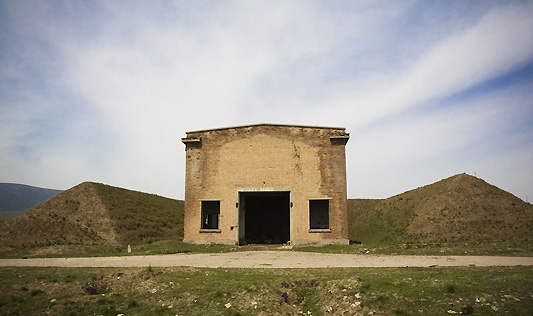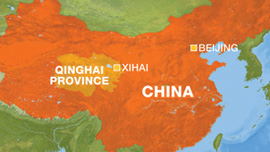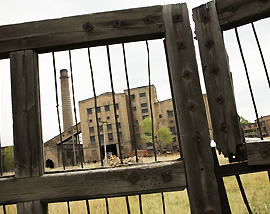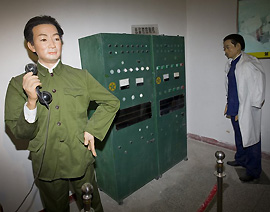China’s latest hot ticket
The once top secret factory that built China’s bomb opens its doors to tourists.

 |
| Off-limts for decades, the remains of China’s secret nuclear city are being opened to tourists |
Just north of the scenic Qinghai Lake in China’s remote northwest, Asia’s “No 1” radioactive waste pit has just opened its doors as one of the country’s newest and most unlikely tourist attractions.
The dump, which looks like a small grassy hill, is part of a once top secret “atomic city” which the government is slowly opening up to visitors.
China’s first nuclear weapons research and production base began operating in 1958 and was run covertly for 30 years out of the town of Xihai, about 100km from the regional capital, Xining.
 |
| Officials say the new museum will “inspire patriotism” in Chinese visitors |
Thousands of scientists at this secret military facility conducted the crucial research that gave China its first atomic and hydrogen bombs in the 1960s.
Last month China opened the base’s underground headquarters in Xihai to tourists.
The subterranean offices are buried almost 10 metres underground and shielded by a lead casing 1.6m thick.
Liu Mei Mei a 22-year-old office worker from Xi’an is one of the first curious visitors touring the site with a group of friends.
“I like it,” she says shyly. “I think it’s very mysterious.”
A three-tonne steel door with heavy locks marked the front entrance to the base – with an escape tunnel at the back “in case anything goes wrong,” says the guide.
Military officers and scientists would also have to pass through a small decontamination chamber before gaining entrance into the lead-lined crypt of 10 or so rooms which make up the headquarters.
It is cold underground and gloomy; the guide’s torch does little to dispel the pallor of the strip lighting.
From inside this top secret bunker updates on the “bomb” were relayed to China‘s then-premier, Zhou Enlai, via a direct telephone link in one of the communications rooms.
Working order
 |
There is also a switchboard, telegraph machine, and giant batteries. “Everything’s in perfect working order, but of course technology has changed since then,” the guide jokes.
The command room’s imposing desk has a TV and a box of sharpened pencils.
Next door, a pair of crude wooden-framed beds, their pressed, white sheets stamped with the base’s logo – a red star with the Chinese characters for 221 – provide the headquarters’ sole sleeping space.
The toilet is a concrete cupboard and bare. “There’s no plumbing down here,” the guide says. “They just used a bucket.”
Opened for just a few weeks, the headquarters have yet to prove a huge hit.
| China’s bomb |
|
Chairman Mao said China needed nuclear weapons to be taken seriously as world power Moscow withdrew nuclear advisors in 1960, but China pushed ahead with development alone First uranium nuclear device detonated on October 16, 1964, making China the world’s fifth nuclear power and taking US by surprise On June 17, 1967, China detonated its first hydrogen bomb |
“You are our first foreign tourist,” says Cao Cheng Biao, the site’s director.
“We usually get around 20 or 30 Chinese visitors a day.”
Cao also mans a souvenir stall in the entrance, selling toy yaks, postcards and Mao memorabilia.
But despite the slow start, the local government is optimistic the site will take off as a tourist attraction.
The underground complex “will become a platform for inspiring the patriotism of Chinese people,” China‘s official Xinhua new agency quoted local official Zuo Xumin as saying at the site’s opening.
The headquarters are just one small part of what was once a sprawling weapons development complex.
The base, known as Factory 221, extends more than 1,000 square kilometres or so over the surrounding Jinyintan grasslands.
For 30 years the base was off limits. But now anyone can scramble around the abandoned factory buildings where more than 30,000 scientists, technicians and soldiers toiled, assembling the trial bombs and testing them out.
Some of the buildings lie derelict behind rusted gates while others are used to store livestock.
“Standing in front to protect Chairman Mao,” reads a faded revolutionary slogan painted onto a large red-brick factory.
Test bombs
 |
| Factory 221 was the centre of Mao’s drive to turn China into a world power |
In one part of the facility, known as Factory No. 6, a model lab dug into a bunker has been opened to the public.
Inside, mannequins of scientists stand comically frozen mid-experiment.
Researchers would place their test bombs at a spot some 30 metres outside, peering out of portholes in the lab’s steel wall to monitor the explosions.
It was dubbed the “shooting range”.
Today, Tibetans are selling pony rides to tourists in the next field.
It all seems very crude, but the research here transformed China, still recovering from the disastrous agrarian reforms of the late 1950s, into a nuclear power.
It was an achievement against the odds. The Soviets had pulled out by 1960 after the breakdown in relations between Beijing and Moscow and “Red China” – as it was then known to much of the outside world – was isolated from the West.
At the headquarters, a video shows China’s first atomic bomb test on 16 October 1964 in the neighbouring Xinjiang region.
The bomb was called Device 596 – after the month (June) and the year (1959), that the Soviets reneged on a promise to supply China with a prototype nuclear device.
The video shows crowds of Mao-suited workers leaping for joy as a mushroom cloud spreads out behind them from China’s homegrown bomb.
“I’m really proud of the work done here!” director Cao says, “These scientists ended the West’s monopoly of nuclear power.”
Buried waste
 |
| What was once the peak of China’s technological might is on display |
Beijing shut everything at down at Factory 221 in 1987, in line, it says, with international efforts to curb the spread of nuclear weapons.
It is still thought to maintain an arsenal of about 400 nuclear warheads.
The radioactive waste left over from the years of tests at Factory 221 was reportedly buried 10 meters underground in a pit about 8 km from the town of Xihai, population 10,000.
But few people seem worried about possible health risks.
“There’s no radiation,” says Cao. “You can see the grass is growing fine and people and animals live here with no problem.”
Officials are also keen to stress that the clean up – which, they say, took six years – was thorough.
“Visitors are completely safe because the radioactive pollutants are buried deep enough in the ground,” Xinhua cited Qinghai environmental protection department director general Zhao Haoming as saying.
Fifty years ago in the all-out drive to build China‘s nuclear bomb, the Tibetan nomads were thrown off the grasslands to make way for the base.
Now they are back. Just a few months before the atomic city museum opening its doors, the local government opened a kitsch Tibetan-themed hotel on site of the abandoned nuclear factory.
Dejie Cuomao, a 20-year-old Tibetan hostess at the hotel says she trusts the scientists.
“Every year they come and make tests,” she says. “They make sure it’s safe for us.”
(All photos by James Wasserman)
